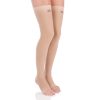
Are Thigh High Compression Socks The Ultimate Solution For Leg Health?
What Are Thigh High Compression Socks?
Thigh high compression socks, also known as compression stockings, are specialized garments designed to improve circulation and provide therapeutic benefits to the legs. Unlike regular socks, these garments apply graduated pressure to the legs, exerting more pressure at the ankles and decreasing as they move up the leg. They are often prescribed by healthcare professionals to alleviate discomfort, reduce swelling, and prevent various leg-related issues.
How Do Thigh High Compression Socks Work?
These stockings work on the principle of graduated compression. The strongest pressure is applied at the ankles, encouraging the blood to flow upward toward the heart. By compressing the veins, arteries, and muscles, they help improve blood circulation, preventing blood from pooling in the lower limbs. This enhanced circulation can reduce swelling, prevent blood clots, and alleviate symptoms associated with various conditions like varicose veins, deep vein thrombosis, and edema.
Who Can Benefit From Thigh High Compression Socks?
Thigh high compression socks offer benefits to a wide range of individuals. They are particularly recommended for:
- Individuals with Varicose Veins:
Varicose veins occur when blood pools in the veins, causing them to swell and appear twisted. Thigh high compression socks can aid in reducing the discomfort and appearance of varicose veins by improving blood flow.
- People at Risk of Deep Vein Thrombosis (DVT):
DVT is a condition where blood clots form in the deep veins of the body, commonly in the legs. These clots can be life-threatening if they break loose and travel to the lungs. Wearing compression stockings can lower the risk of DVT by enhancing blood circulation.
- Individuals Recovering from Surgery:
After surgery, especially procedures involving the legs or lower body, wearing compression stockings can help prevent blood clots and aid in a quicker recovery by reducing swelling and discomfort.
- Pregnant Women:
Pregnancy often leads to swollen legs due to increased pressure on the veins. Thigh high compression socks can offer relief by supporting better circulation, reducing swelling, and alleviating discomfort.
- Athletes and Active Individuals:
Athletes, runners, and individuals engaging in physical activities can benefit from wearing these socks as they help improve oxygen delivery to the muscles, potentially enhancing performance and reducing muscle fatigue.
How To Choose The Right Thigh High Compression Socks?
Selecting the right compression socks is crucial to maximize their benefits:
- Compression Level:
Compression stockings come in various levels of pressure. It’s essential to consult a healthcare professional to determine the appropriate pressure level based on individual needs.
- Size and Fit:
Getting the right size is vital for effectiveness. Measure the legs accurately to ensure a proper fit without being too tight or loose.
- Material and Comfort:
Look for socks made from breathable materials that provide comfort for all-day wear. Moisture-wicking fabrics can prevent excessive sweating and discomfort.
- Style and Design:
Thigh high compression socks come in different styles and colors. Choose a style that suits your preferences and lifestyle.
How Often Should Thigh High Compression Socks Be Worn?
The frequency of wearing thigh high compression socks depends on individual needs and the recommendation of a healthcare professional. However, they are typically worn during the day and removed at night. Some individuals may need to wear them continuously, while others might only wear them during specific activities or for specific durations.
Conclusion: Do Thigh High Compression Socks Work?
Thigh high compression socks or compression stockings have shown significant effectiveness in improving leg health by enhancing blood circulation and reducing various leg-related discomforts. However, their efficacy may vary based on individual needs and conditions. Consulting a healthcare professional for guidance on their usage and the appropriate pressure level is crucial to maximize their benefits and alleviate leg-related issues effectively.



